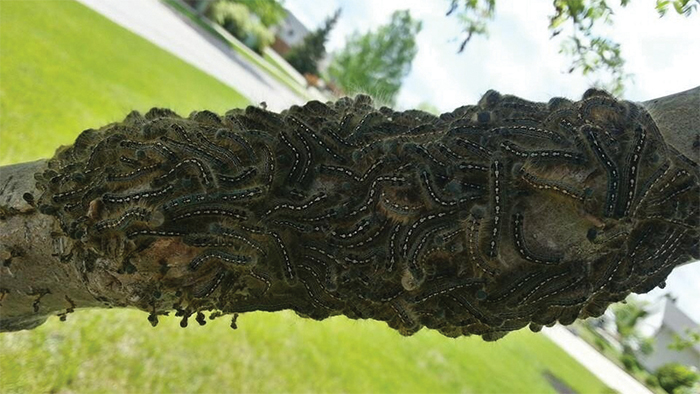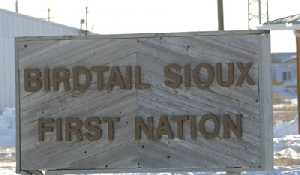Tent caterpillars feasting on local trees
May 25, 2016, 2:09 am
Kevin Weedmark


In several towns around the area, an infestation of tent caterpillars is attacking trees, leaving some with almost no leaves.
If not sprayed or otherwise dealt with, tent caterpillars can eat all the leaves off a tree, but will not kill it—the leaves will grow back.
Moosomin Director of Public Works Kim Looyenga says the town doesn’t plan to spray for the caterpillars but may try to deal with them in the fall to prevent a problem next year.
She said provincial officials have told her that the infestation is simply part of a 10-year natural cycle.
She first ran into the worms in her own yard two weeks ago.
“I personally had them in my yard on May 8—that’s the first day I noticed them,” she said. “A tree in my back yard had them, and by the middle of the afternoon I had them all over my garage. I went and took some Raid and annihilated the creatures.
“We started getting complaints from the public May 10. That day they were marching across the street from Conexus and were climbing up the glass on the town office tower. They move in big groups, so people are sometimes surprised to see them moving like that.
“When I called the ministry of agriculture they just said it’s natural, we might just be in a one in 10-year cycle. They assured me the trees will survive. They can defoliate the entire tree, but the tree will survive.”
She said the town has not sprayed for them in the past, but may look at control measures in the fall to prevent another infestation next spring.
“After they lay their eggs in fall, if you cut them out and burn them that’s the most effective way to control them,” says Looyenga.
“In the fall if we see a lot of the eggs we may do that.
“Some people have been using Sevin powder and BTK, which is the best way to spray them.
“Most people have been managing it themselves, using Raid or putting Sevin dust on them.
“In one area, all the neighbors are getting together and spraying them with water, dish soap and vinegar, which is making them fall off their trees.”
Looyenga said there is a small window when the leaves are young that tent caterpillars are a problem in trees.
The following information was compiled by Brent Elliott, Entomologist, and Don Dixon, provincial apiarist, with Manitoba Agriculture and Food
Tent caterpillars feed on a wide variety of trees including fruit trees, trembling aspen, balsam poplar, cottonwood, bur oak, green ash, white birch, white elm, basswood, sugar maple, Manitoba maple, saskatoon and chokecherry.
The larvae hatch in spring. They feed on leaves in groups and spin a trail of silk wherever they go. When not feeding they rest in masses, usually on trees, but when there are large numbers they are sometimes found on roads and sides of buildings. They feed for five or six weeks after hatching and then form cocoons. Adults emerge about 10 days later. Female moths deposit eggs on twigs in a small band that contains 150 to 200 eggs. In most years the eggs do not hatch until the following year.
Injury to trees is the defoliation due to larval feeding. Feeding continues for about five or six weeks (typically until mid-June) when the larvae form cocoons. Two or more years of moderate to severe defoliation can cause some branches and twigs to die off. There is rarely any tree mortality directly attributable to defoliation even with complete defoliation. The trees re-foliate quite quickly (within two weeks to a month) and produce enough new leaves to carry on photosynthesis. Little lasting damage is caused to the trees.
When the colonies are young and low on trees or shrubs, pruning by hand and burning the nests is a safe and effective control measure.
Most efforts to control the caterpillars are done with the use of pesticides. The preferred method of control is to use a biological control agent, Bacillus thuringiensis kurstaki (Btk). This pesticide has limited non-target effects and is non-toxic to humans and mammals. It is critical to realize that unlike regular insecticides (eg. Malathion, diazinon, etc.), Btk must be ingested by the caterpillars and does not have any contact activity against the pests. This means that spraying Btk directly on the caterpillars and/or their nests will not do anything. Btk must be sprayed on the foliage that the caterpillars are eating so that they can ingest it. When the caterpillars ingest the Btk, they typically cease feeding and will not die for a couple of days.
Many people prefer to use conventional insecticides so that the insects die immediately. This is fine, but people are reminded of a couple of issues. First, these products, if used improperly, can be dangerous. Proper protective equipment should be used and the label instructions should be followed exactly.
Insecticides can have a very substantial negative impact against honeybees and native bees. The late spring has meant that there were few if any flowers and nectar sources for the bees. Now with a flush of flowers, the bees are quite actively seeking sources of nectar. Many people primarily concerned with protecting their trees from tent caterpillars do not initially consider possible effects of sprays to the bees. This is a critical time of year for honey bee development, especially this year with the late spring. Anything that disrupts honey bee colony development, including pesticide injury, could reduce honey bee populations and severely limit honey production when the main crops come into bloom during the summer. Some rural municipalities are planning larger scale spraying activities and welfare of pollinators in general must be kept in mind. Spraying with Btk should have no effects on bees. If other insecticides, such as Malathion, are used, every effort should be made to apply the insecticide in the late evening when the bees are not active. Delaying spray activity until bloom is over will also help protect the bees. If non-Btk insecticides are used, applicators should be very wary of any possible drift, particularly in areas where commercial beekeepers may keep their beehives. Advising local beekeepers of the intent to apply insecticides will also allow the beekeepers and pesticide applicators to work together to prevent bee losses.



































